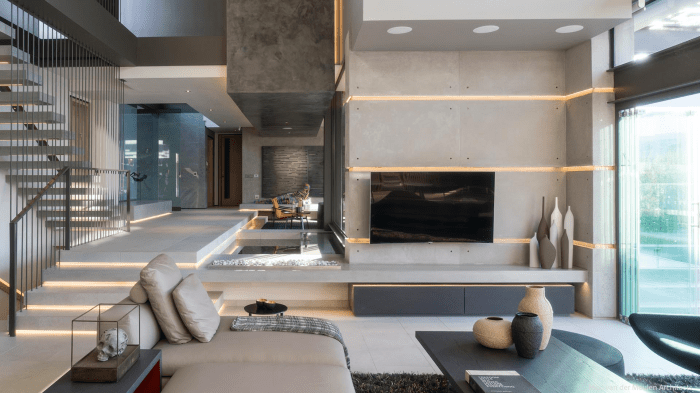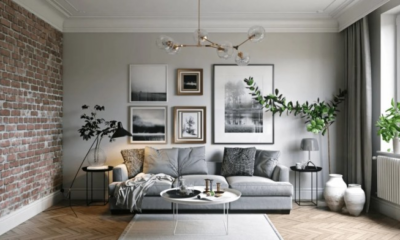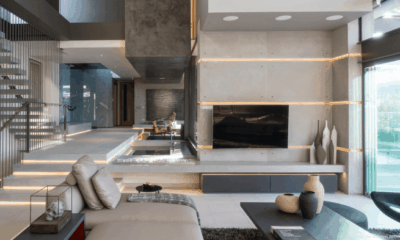Design
Unveiling the World of Architecture and Interior Design

Embark on a journey through the realms of architecture and interior design, where creativity meets functionality to shape the spaces we inhabit. This intriguing overview delves into the significance of these fields in our daily lives, showcasing iconic works that have left a lasting impact on the world.
As we explore the key elements of architectural design, principles of interior design, sustainable practices, and the historical evolution of these disciplines, you'll gain a deeper understanding of the artistry and innovation behind creating captivating spaces.
Importance of Architecture and Interior Design
Architecture and interior design play a crucial role in shaping the spaces we live, work, and interact in. They go beyond mere aesthetics, influencing our moods, behaviors, and overall well-being.
Impact on Daily Lives
Architecture and interior design impact our daily lives in numerous ways. The layout of a building can affect how we navigate through it, with well-designed spaces promoting efficiency and comfort. For example, a thoughtfully designed office space with natural light and ergonomic furniture can boost productivity and employee satisfaction.
On the other hand, poorly designed spaces can lead to feelings of claustrophobia, stress, and discomfort.
Iconic Works Around the World
There are several iconic architectural and interior design works around the world that have left a lasting impact on society. The Guggenheim Museum in Bilbao, Spain, designed by Frank Gehry, is a masterpiece of contemporary architecture that has revitalized the city and become a symbol of innovation.
Another notable example is the Palace of Versailles in France, known for its opulent interiors and expansive gardens, showcasing the grandeur of French Baroque design. These iconic works not only serve as landmarks but also inspire future generations of architects and designers.
Elements of Architecture
In architectural design, several key elements come together to create a cohesive and functional structure. These elements include form, function, structure, materials, textures, natural light, and ventilation.
Form
Form in architecture refers to the overall shape and appearance of a building. It includes elements such as the building's massing, proportions, and style. The form of a building not only affects its aesthetic appeal but also influences its functionality and the experience of its occupants.
Function
The function of a building is a crucial element in architectural design. It determines how the space will be used and influences the layout, circulation, and organization of the building. Architects must carefully consider the purpose of the building and the needs of its users to create a design that meets both aesthetic and practical requirements.
Structure
The structural system of a building is essential for supporting its weight and ensuring its stability. Architects must consider the materials and construction methods used to create a safe and durable structure. The structural design also plays a significant role in defining the overall aesthetic of the building.
Materials and Textures
Materials and textures play a vital role in architectural design, creating visual interest and tactile experiences. The choice of materials, such as wood, glass, concrete, or steel, can influence the look and feel of a building. Textures, whether rough or smooth, add depth and character to the design, enhancing the overall aesthetic.
Natural Light and Ventilation
Natural light and ventilation are crucial considerations in architectural planning. Properly designed windows, skylights, and openings allow natural light to enter the building, reducing the need for artificial lighting and creating a more comfortable and inviting space. Adequate ventilation helps regulate indoor air quality and temperature, promoting a healthy environment for occupants.
Principles of Interior Design
Interior design principles play a crucial role in creating visually appealing and functional spaces. These principles guide designers in achieving balance, harmony, and rhythm within a space, ultimately enhancing the overall aesthetic appeal and functionality.
- Balance:Balance in interior design refers to the distribution of visual weight in a room. It can be achieved through symmetrical, asymmetrical, or radial balance, ensuring that the elements in the space are evenly distributed.
- Harmony:Harmony involves creating a cohesive and unified look in a space by ensuring that all elements work together seamlessly. This can be achieved through color schemes, patterns, and textures that complement each other.
- Rhythm:Rhythm in interior design refers to the visual flow and movement within a space. It can be achieved through the repetition of elements such as colors, patterns, or shapes, creating a sense of continuity and visual interest.
Role of Color, Pattern, and Scale
Color, pattern, and scale are essential elements in interior design that significantly impact the overall look and feel of a space.
- Color:Colors can evoke different emotions and set the mood of a room. Warm colors like red and orange can create a cozy atmosphere, while cool colors like blue and green can promote relaxation. Designers use color schemes to create a harmonious and balanced look in a space.
- Pattern:Patterns add visual interest and texture to a room. Whether through wallpaper, fabrics, or accessories, patterns can be used to create focal points or add depth to a space. Mixing different patterns can create a dynamic and layered look.
- Scale:Scale refers to the size of objects in relation to the space they occupy. Proper scaling is essential to ensure that furniture and decor items are proportionate to the room. Oversized furniture in a small room can make the space feel cramped, while undersized pieces can look out of place.
Furniture Layout for Enhancing Interior Spaces
The layout of furniture in a room can significantly impact the functionality and aesthetics of the space
- Placing furniture away from walls can create a more intimate and cozy seating arrangement.
- Using area rugs to define separate zones within a room can help in visually dividing the space.
- Arranging furniture in conversation areas can promote social interaction and create a welcoming atmosphere.
Sustainable Design in Architecture and Interior Design

When it comes to sustainable design in architecture and interior design, the focus is on creating spaces that have a minimal impact on the environment while maximizing energy efficiency and use of eco-friendly materials.
Concept of Sustainable Architecture and Interior Design
Sustainable architecture and interior design aim to reduce the negative environmental impact of buildings and spaces by efficiently using resources, such as energy and water, throughout the lifecycle of a project.
Use of Eco-Friendly Materials and Energy-Efficient Solutions
- Utilizing recycled materials and sustainable resources like bamboo, reclaimed wood, and recycled glass in construction and interior finishes.
- Incorporating energy-efficient lighting systems, appliances, and HVAC systems to reduce energy consumption and lower carbon footprint.
- Implementing passive design strategies such as natural daylighting, shading, and insulation to minimize the need for artificial heating and cooling.
Examples of Sustainable Buildings and Interiors
Some notable examples of buildings and interiors that prioritize sustainability include:
- The Edge in Amsterdam, known as the world's most sustainable office building, featuring solar panels, rainwater harvesting, and smart energy systems.
- The Bullitt Center in Seattle, a commercial building that generates its own renewable energy through solar panels and composting toilets.
- The interior of Etsy's headquarters in Brooklyn, designed with salvaged materials, energy-efficient lighting, and a focus on indoor air quality.
Historical Evolution of Architecture and Interior Design
Architecture and interior design have a rich history that has evolved over the centuries, influenced by various cultural, social, and technological factors.
Architectural Styles from Ancient to Modern Times
Architecture has undergone significant changes from ancient times to the modern era, reflecting the advancements in building techniques, materials, and design philosophies.
- Ancient Architecture: The architectural styles of ancient civilizations such as Egyptian, Greek, and Roman showcased grand structures like pyramids, temples, and amphitheaters, characterized by symmetry, columns, and ornate details.
- Medieval Architecture: The medieval period saw the rise of Gothic architecture with pointed arches, ribbed vaults, and flying buttresses, seen in cathedrals and castles across Europe.
- Renaissance Architecture: The Renaissance brought a revival of classical forms and proportions, with prominent architects like Leonardo da Vinci and Michelangelo leading the way in Italy.
- Modern Architecture: The 20th century witnessed the emergence of modernist movements like Bauhaus, Art Deco, and International Style, emphasizing simplicity, functionality, and innovation in design.
Evolution of Interior Design Trends
Interior design trends have also evolved over different historical periods, reflecting changing lifestyles, tastes, and design preferences.
- Victorian Era: The Victorian period was known for ornate and elaborate interiors, featuring heavy drapery, dark woods, and intricate detailing, influenced by Queen Victoria's reign in the 19th century.
- Art Deco Movement: The Art Deco style of the 1920s and 1930s embraced geometric shapes, bold colors, and luxurious materials, inspired by the machine age and modern technology.
- Mid-Century Modern: The mid-20th century saw the rise of mid-century modern design characterized by clean lines, organic forms, and minimalist aesthetics, popularized by designers like Charles and Ray Eames.
Key Movements and Architects in Architecture and Interior Design
Throughout history, key movements and architects have left a lasting impact on the fields of architecture and interior design, shaping the way we perceive and interact with built environments.
- The Bauhaus Movement: The Bauhaus school in Germany, led by Walter Gropius, emphasized the integration of art, craft, and technology, influencing modern design principles and architectural education.
- Frank Lloyd Wright: The pioneering architect Frank Lloyd Wright introduced organic architecture, blending nature with the built environment, evident in iconic structures like Fallingwater and the Guggenheim Museum.
- Zaha Hadid: The visionary architect Zaha Hadid pushed the boundaries of form and function with her innovative designs, such as the Heydar Aliyev Center in Azerbaijan and the London Aquatics Centre.
Epilogue
In conclusion, the intricate dance between form and function, aesthetics and sustainability in architecture and interior design continues to inspire and enrich our lives. From ancient architectural marvels to modern sustainable solutions, these disciplines shape the way we perceive and interact with our environment, leaving a legacy of beauty and purpose for generations to come.
Essential FAQs
What role does natural light play in architectural design?
Natural light not only illuminates spaces but also affects the ambiance and mood of a room, emphasizing architectural details and creating a sense of warmth and openness.
How can color impact the perception of space in interior design?
Color can visually alter the size and mood of a room, with lighter tones creating a sense of spaciousness and darker hues adding coziness and intimacy.
What defines sustainable design in architecture and interior design?
Sustainable design focuses on minimizing environmental impact through the use of eco-friendly materials, energy-efficient solutions, and practices that prioritize long-term ecological balance.
-

 General6 months ago
General6 months agoFinding the Best Siding Contractors Near Me: A Comprehensive Guide
-

 General6 months ago
General6 months agoExploring the World of Interiors
-

 General6 months ago
General6 months agoEnhancing Your Home: Custom Home Exteriors
-

 General6 months ago
General6 months agoExploring the Roof Replacement Cost Estimate: Factors, Materials, and Labor
-

 General6 months ago
General6 months agoThe Ultimate Guide to Licensed Home Improvement Contractors
-

 General6 months ago
General6 months agoExploring the Beauty of Hardie Cobblestone
-

 Architecture6 months ago
Architecture6 months agoExploring the World of Interior Architecture
-

 General6 months ago
General6 months agoExploring the Best Replacement Window Companies for Your Home





